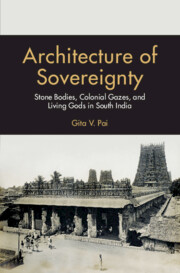Book contents
- Frontmatter
- Dedication
- Contents
- List of Figures
- Acknowledgments
- Notes on Transliteration and Spelling
- Introduction: Sovereignty’s Trace in Architectural Forms
- Part I Stone Bodies
- Part II Colonial Gazes
- Part III Living Gods
- Epilogue: Rejecting the State—Priestly Devotion and Protest in Modern Madurai
- Bibliography
- Index
5 - Illustrating Madura: Art as ‘History’ and State-Building
Published online by Cambridge University Press: 19 April 2023
- Frontmatter
- Dedication
- Contents
- List of Figures
- Acknowledgments
- Notes on Transliteration and Spelling
- Introduction: Sovereignty’s Trace in Architectural Forms
- Part I Stone Bodies
- Part II Colonial Gazes
- Part III Living Gods
- Epilogue: Rejecting the State—Priestly Devotion and Protest in Modern Madurai
- Bibliography
- Index
Summary
Introduction
On January 16, 1845, Captain John Lock donated a volume of miscellaneous drawings he had commissioned to the East India Company Library in London. The first five drawings, dated 1841, depict occupations and festivals in Madras. One painting shows a row of dark-complexioned Hindu pilgrims and ascetics, and another displays musicians, Brahmins, and dancing girls participating in a raft festival (Figure 5.1). In both images, figures appear extracted from a larger scene, detached from their original environs, and plunked horizontally onto the open space. Inscribed at the bottom of each painting is “Just Gantz. Popham's Broadway. No. 35. Madras 1841,” the inscription of artist and architect Justinian Gantz (1802–1862) who operated a lithographic press with his father, John Gantz (1772–1853), an East India Company draughtsman of Austrian origin. Their press, Gantz & Sons (rival to the famous bookseller Higginbotham), was in George Town's main commercial street in Fort St George, the headquarters of the East India Company's Madras Presidency.
Lock's book, called Hindoo & Architectural Drawings in Southern India, contained three illustrations of Madurai and Rameswaram, two major pilgrimage sites in peninsular India. These mainly sepia wash watercolors were produced by W. G. P. Jenkins, William Walter Whelpdale, and Ravant Naik: Jenkins and Whelpdale served in the Madras Army in the 1830s, and Naik was likely a Madurai artist working as an East India Company draughtsman. Two paintings portray Tirumala Nāyaka's palace courtyard and his Pudu Maṇḍapam at the Mīnākṣī-Sundareśvara temple (Figure 5.2). In each image, the edifice encompasses the entire page in a beige, brown, and blue tricolor scheme. The commanding frontal view of these buildings draws the viewer inward into its dark interior depths, as the use of shadow obscures and conceals the interior of buildings and produces a sense of mystery.
Hindoo & Architectural Drawings captures various aspects of south Indian life: people of diverse castes and occupations—often dressed in colorful costumes and reveling in religious festivals—flank static depictions of a temple, palace, and pillared hall. This juxtaposition of bodies and buildings illuminated two interconnected fascinations for the British in India: ethnicity and architecture. As a collector, Lock patronized many artists and purchased their paintings of India; Tremul Naig's Choultry is one souvenir that Lock brought back to England to exhibit a flavor of the British colony.
- Type
- Chapter
- Information
- Architecture of SovereigntyStone Bodies, Colonial Gazes, and Living Gods in South India, pp. 156 - 200Publisher: Cambridge University PressPrint publication year: 2023



